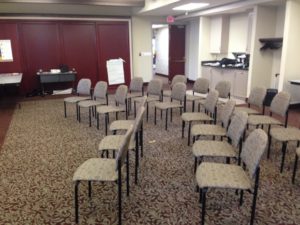Know the Room – Own the Room when You Present
Do you want to own the room when you speak?
A successful presentation starts when you own the room. When you own the room, you will be a more powerful and confident presenter. That leads to more successful presentations.
Are you ready to own the room?
Consider this. While strolling in your neighborhood you will feel more comfortable and confident then in a strange town. A sports team usually feels stronger when playing at home. Delivering a presentation is certainly a competitive event. Why not do it on your home turf?
When you present, how can you own the room?
“Owning the room” is a feeling that you can spark within yourself by knowing the room.
How do you know the room?
When you’re are speaking out of town, knowing the room might mean arriving the day before your presentation. In the worst case, arrive at least one hour before your presentation. Don’t breeze in 10 minutes before your speak and expect to “own the room”.
Get into the room well before your presentation – preferably when no one else is there. That allows you to make the following preparations.
You can see the room and start visualizing how you will present and how your audience will look. Visualizing yourself presenting in the room is an effective way to prepare for your presentation. You will feel more comfortable and more powerful if you’ve been in the room before your presentation.
If the room is not the right size for the audience expected you can change the room to make it appear smaller or even arrange for another room.
You can check the setup of the room. Become familiar with the layout of the seating, tables, doors, curtains and other characteristics of the room. Walk around the room and sit in different seats so you understand better how the audience might or might not see you and your visuals during your presentation. Look for blind spots.
If the seating is not the way you prefer and it can be changed, then arrange for it to be changed to the way you want. Sometimes this might mean making those changes yourself. (I’ve done this the night before an important presentation at a conference.)
Play with the switches. Test all the lights, AV and climate control switches. Tape the ones that should not be changed. Discover the ones that give you the settings you want so you can set it quickly or explain to an assistant how to do it.
Check the doors to learn which ones are noisy – so you can tape the latches. Which are the outer halls that need a “Do Not Enter” sign taped on the outside? Which lead to the washrooms so you can direct people? When you got to go – nothing is more important. Where are the emergency exits in case they are needed?
Rehearse walking on and off the stage so you don’t trip. It’s surprising how simple things like walking on stage can be nerve wracking when you are giving a presentation.
Stand on the stage and practice delivering your presentation. Move about the stage to feel comfortable and find the cracks or creaky boards that you need to avoid. Check the position of the speakers to avoid feedback. Test the microphone when the AV people are there. Often they test the microphone for one of their staff then disappear.
One more tip. Change or move something to make the room yours. Close the curtains, move some chairs, put a small table on stage… It might not be much but any small change that you make can help you feel better when you take the stage.
I’ve delivered over 2,000 presentations and I’ve noticed that the room can make a significant difference on the energy of the audience and success of the presentation.
Know the room – own the room.
What tips can you offer to own the room?
Related Posts for you

